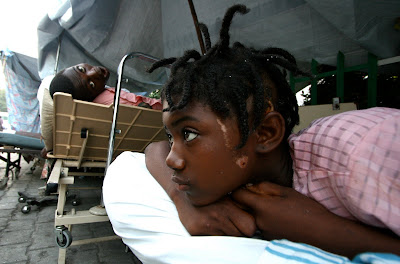 In a small room Dominican workers were bustling from one table to another, recording the injuries of those already evacuated onto a common document. Four columns, scratched onto unlined paper: name, age, injury, nationality. Martine, 12, fracture, Haitian. Josue, 9, break, Haitian. Still unsure of what my role would be in the recovery efforts, I knew I had to get across the border, against the human tide coming the other direction. I caught a ride towards the border at 6am the following Saturday. It was a restless 200 miles to Port au Prince in a small truck.
In a small room Dominican workers were bustling from one table to another, recording the injuries of those already evacuated onto a common document. Four columns, scratched onto unlined paper: name, age, injury, nationality. Martine, 12, fracture, Haitian. Josue, 9, break, Haitian. Still unsure of what my role would be in the recovery efforts, I knew I had to get across the border, against the human tide coming the other direction. I caught a ride towards the border at 6am the following Saturday. It was a restless 200 miles to Port au Prince in a small truck.As a photographer abroad, I've seen and documented suffering and poverty before. I was not ready for a post 7.0 Haiti.
As we descended into the capital, my chest tightened. Along the horizon, plumes of brown smoke stained the clear blue sky. Helicopters jockeyed, their movements mirroring the frantic scenario swirling beneath their skids. Arriving at the Hopital Université d'Etat d'Haiti, eight hours later, I stepped into a ripe heat. I pulled out my camera. Less than ten minutes later, I put it down again.
The hospital entrance was blocked by chain of volunteers moving crates of water from a relief truck. I tried to duck or squeeze my way through, get a better angle for my camera. There was no room. Photographically, the scene was aesthetically perfect. Haitians, Spaniards, and American GIs worked together, hefting hundred of crates into the hospital. I again tried to get past the chain, wanting the shot. A Haitian doctor turned and slammed into me with a case of water, pinning my camera to my chest. Our eyes met; he made a comment I couldn’t understand. I paused, swallowing. I put my camera in my bag. They needed my back, my legs, and my arms. Not my lens.
Later, walking through the chaotic streets of Haiti, my insecurity overwhelmed me. It wasn't an insecurity rooted in my inability to speak the language. I didn't feel physically threatened. I was insecure because this titanic suffering was mine to document, but also mine to escape from. In a such a place, where every single Haitian was suffering, the very concept of value changes. Water, food, medicine, stitches. That's what literally everyone needed. My camera was nearly obscene in its degrees of removal from the immediate needs of the Haitian people. "We," as journalists, photographers and videographers, swarmed the streets. A Haitian man tending to his wounded brother, prone in an old pickup, epitomized the question already pulsing in my head: "what can your photos do for us?"
A mother called to me as she unwrapped her young child. She pulled back a perfectly white sheet. Both of the child's legs were amputated at the knee. My eyes filled with tears. The child squirmed while the mother, exhausted, pointed at her child and then at my camera. She wanted me, my camera, and others to share the tragedy she had endured. I didn't want to take this picture. She insisted. This scene repeated itself over and over for three days.
The bus left the Dominican Embassy in the evening. Evacuees filled the back half of the vehicle, and were silent. When I finally made it to my hotel in Santo Domingo, so tired that I felt crazy, I edited the photos instead of sleeping. I had to get them out. The urgency I felt that night was only matched by the incredible hopelessness I had felt many times in the last three days of carrying water, loading food, and setting up tents, and occasionally taking photos. Journalists are often criticized for pursuing personal advancement at the cost of human exploitation. Haiti may become the best covered crisis in journalistic history. Let it it also be an acute lesson in the importance of a more engaged, human journalism. Ones photos mean more if ones hands did more than carry a camera bag.

















